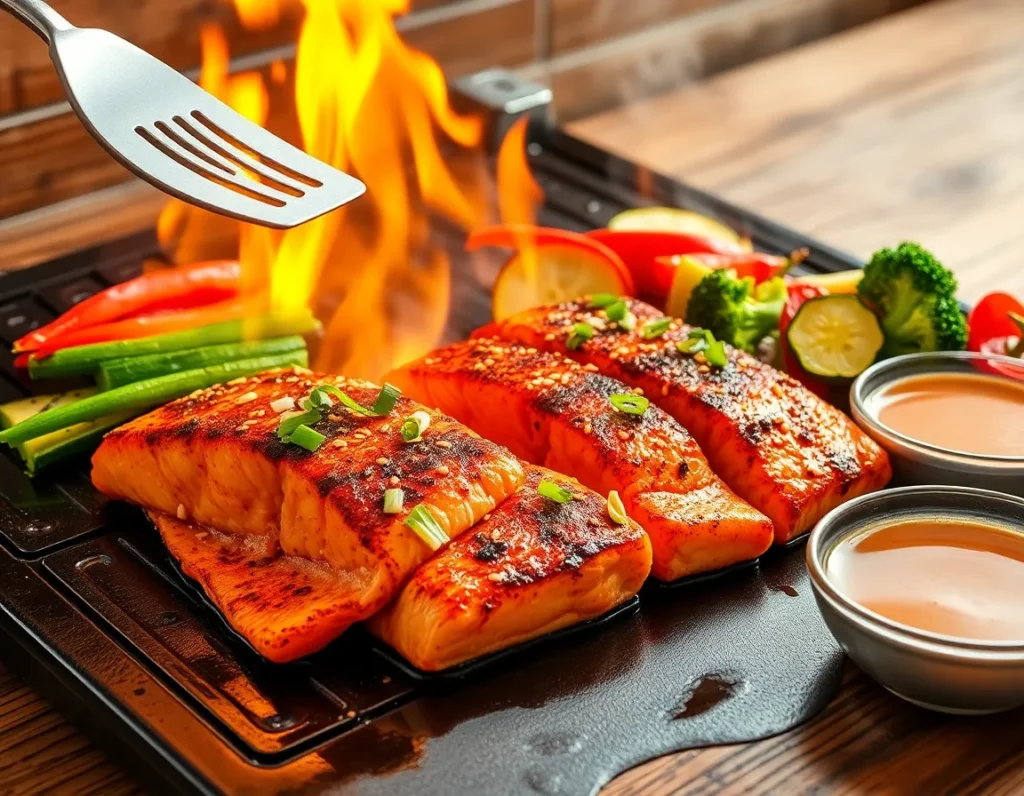Dive into the vibrant world of Japanese cuisine with our Hibachi Salmon Recipe, where sizzling flavors and captivating aromas come together in a delightful dance on your stovetop. Both beginners and seasoned cooks will appreciate the simplicity and elegance of this dish, which transforms a humble piece of salmon into a restaurant-worthy experience. With its tender, flaky texture and a perfect balance of savory soy, zesty ginger, and a hint of garlic, this recipe is a feast for the senses.
Picture the rich, caramelized glaze enveloping each salmon fillet, as the sizzling sounds from the skillet invite anticipation. This recipe celebrates the art of cooking with its straightforward steps, allowing you to channel your inner hibachi chef with confidence. Whether you’re crafting a quick weeknight meal or impressing guests with your culinary flair, this Hibachi Salmon promises a mouthwatering journey that’s as enjoyable to prepare as it is to savor.
About This hibachi salmon Recipe
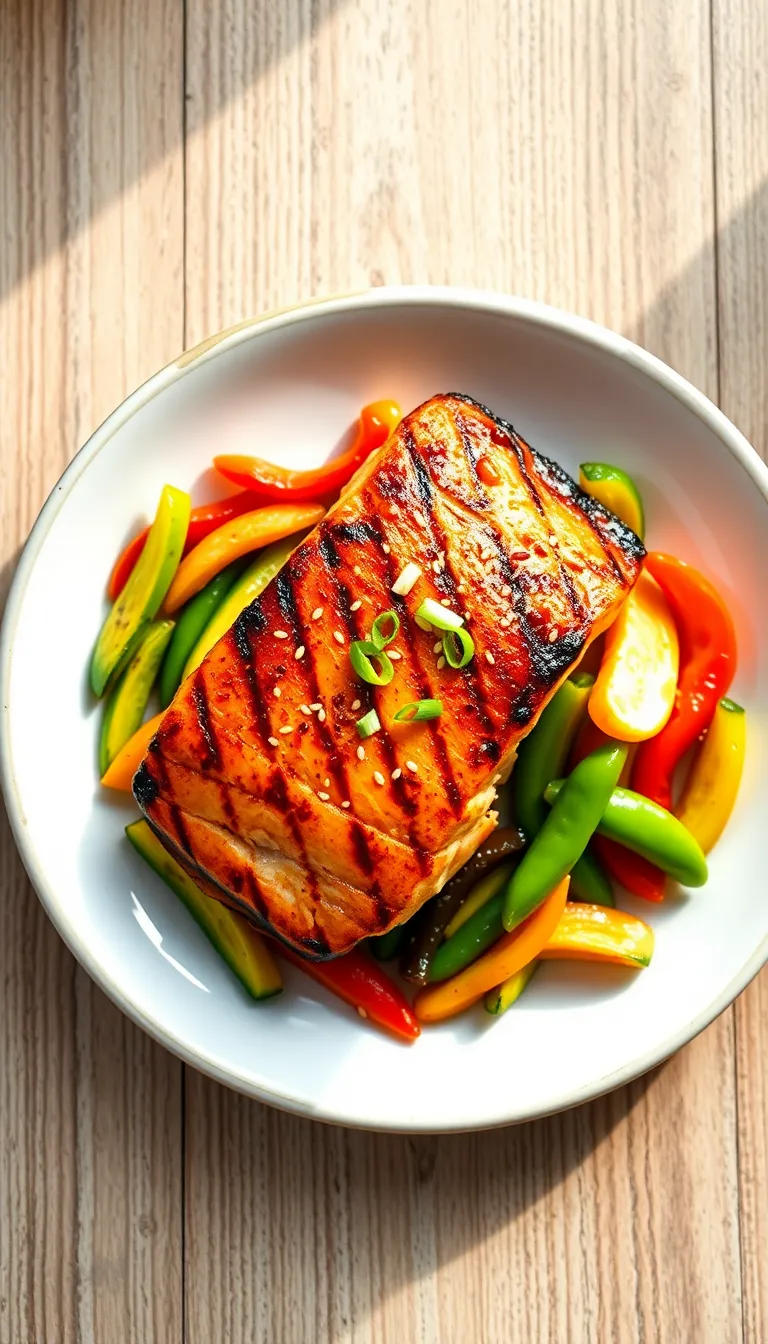
- Quick and Easy: This Hibachi Salmon recipe can be prepared in under 30 minutes, making it perfect for busy weeknights.
- Restaurant-Quality at Home: Enjoy the flavors of a Japanese steakhouse right in your kitchen with this authentic and simple preparation.
- Deliciously Flavorful: The rich, buttery salmon is enhanced with a savory soy-ginger glaze that tantalizes your taste buds.
- Healthy and Nutritious: Packed with omega-3 fatty acids, this dish is not only tasty but also supports heart health and overall wellness.
- Versatile Pairings: Perfectly complements a variety of sides, from steamed rice to stir-fried vegetables, making it adaptable to any meal.
- Impressive Yet Simple: Impress your family and friends with this elegant dish that requires minimal effort and ingredients.
Why You’ll Love This Recipe
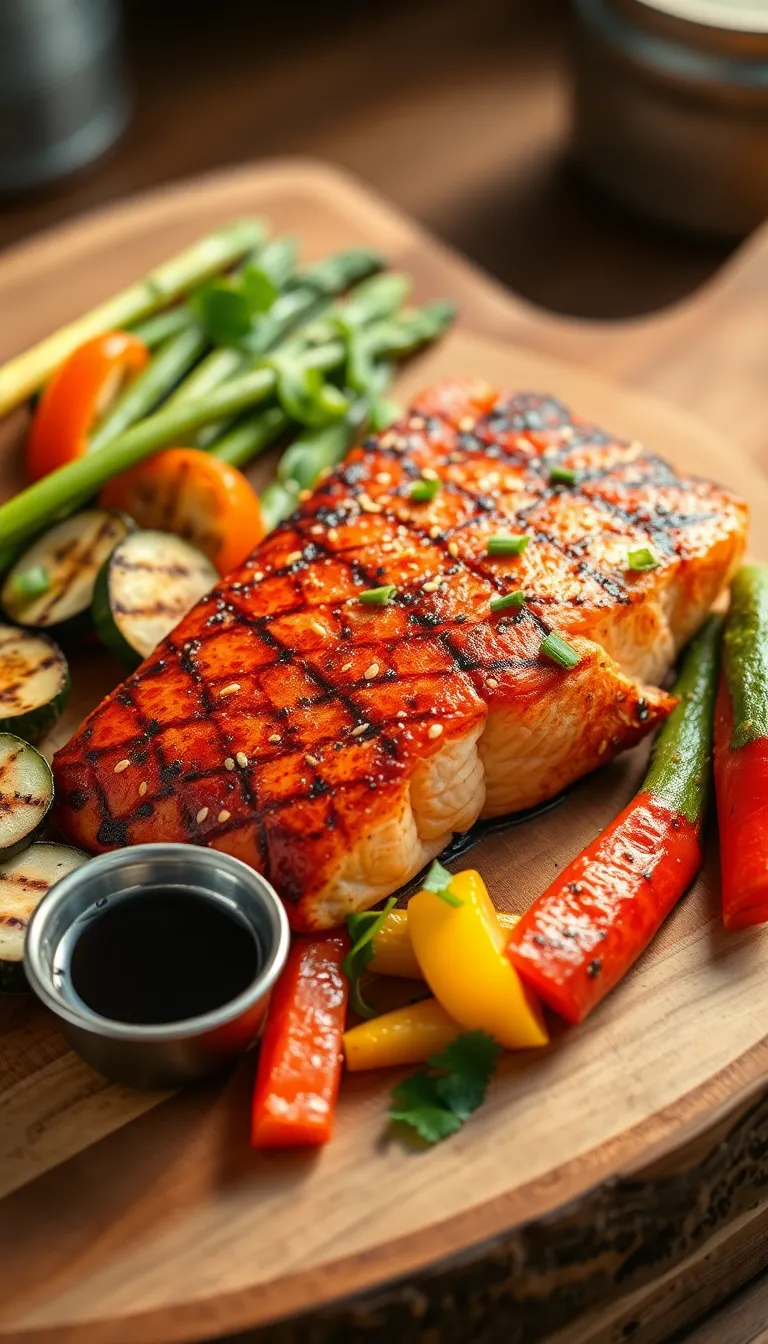
- Quick and Easy: This hibachi salmon recipe is perfect for busy nights, taking less than 30 minutes from start to finish.
- Rich in Flavor: Experience a delightful blend of savory soy sauce, sweet mirin, and fragrant ginger that elevates the salmon to restaurant-quality taste.
- Healthy and Nutritious: Packed with omega-3 fatty acids, this dish supports heart health while providing a delicious meal.
- Versatile Pairing: Serve it with rice, noodles, or steamed vegetables to create a balanced and satisfying meal every time.
- Authentic Experience: Bring the fun and flavor of a Japanese steakhouse to your own kitchen with this authentic hibachi-style salmon.
- Kid-Friendly: The mild and pleasing flavors make it a hit with both adults and children, ensuring a meal the whole family will enjoy.
Ingredients
- 4 salmon fillets (about 6 ounces each)
- 2 tablespoons vegetable oil
- 1/4 cup soy sauce
- 2 tablespoons mirin
(a sweet Japanese rice wine, substitute with a mix of rice vinegar and sugar if unavailable)
- 1 tablespoon sake
(Japanese rice wine, can be substituted with dry sherry or vermouth)
- 1 teaspoon sesame oil
- 2 cloves garlic, minced
- 1 tablespoon ginger, minced
- 1 tablespoon honey
- 1 lemon, sliced
- 1 tablespoon sesame seeds, toasted (optional)
- 2 tablespoons green onions, chopped (optional)
- Salt and pepper to taste
Kitchen Tools You’ll Need
- Non-stick Skillet or Griddle: Essential for cooking the salmon and vegetables evenly without sticking. A cast-iron skillet can be used as an alternative for added flavor.
- Fish Spatula: Ideal for flipping the salmon gently without breaking it apart. A regular spatula can be used if a fish spatula is unavailable.
- Chef’s Knife: Necessary for slicing vegetables and preparing garnishes efficiently. Ensure it’s sharp for precision cutting.
- Cutting Board: Provides a stable surface for chopping and slicing ingredients safely.
- Mixing Bowls: Used for marinating the salmon and mixing sauces or dressings. Multiple sizes can be helpful for separating ingredients.
- Whisk or Fork: Useful for blending marinade ingredients thoroughly. A fork is a simple alternative if a whisk is not available.
- Measuring Spoons and Cups: Important for accurately measuring ingredients to maintain the recipe’s balance of flavors.
Preparation Steps
Preparation Steps
- Preheat the grill to medium-high heat, approximately 400°F (200°C). Ensure the grill grates are clean and lightly oiled to prevent sticking.
- Pat the salmon fillets dry with paper towels and season them with salt and pepper on both sides.
- In a small bowl, combine soy sauce, lemon juice, garlic, and ginger to create the marinade. Stir well.
- Brush the marinade over the salmon fillets, ensuring they are evenly coated. Let them sit for 5 minutes to absorb the flavors.
- Place the salmon fillets skin-side down on the preheated grill. Cook for 4-5 minutes until the skin is crispy.
- Flip the salmon carefully and grill for an additional 3-4 minutes until the flesh is opaque and flakes easily with a fork.
- Remove the salmon from the grill and let it rest for 2 minutes before serving. Garnish with chopped green onions if desired.
Serving Suggestions
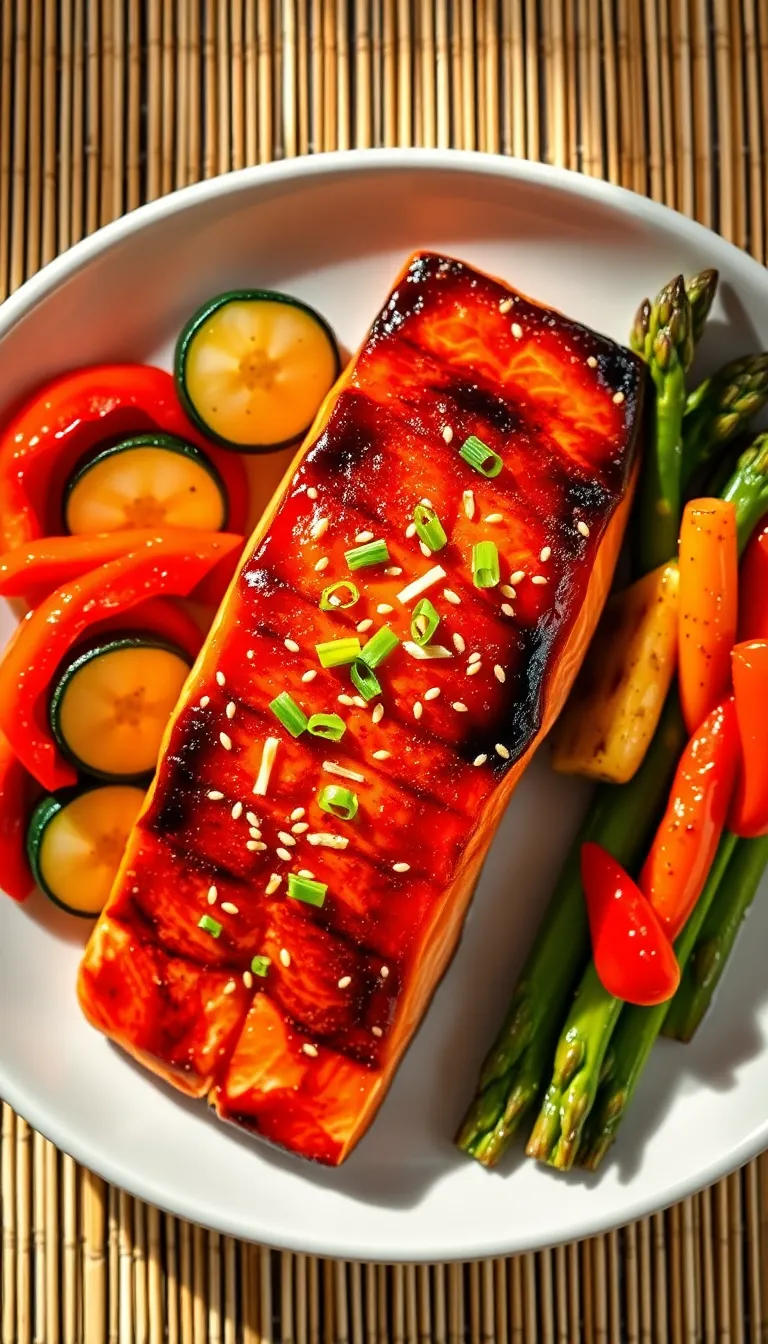
- Pair the hibachi salmon with steamed jasmine rice. The soft texture and subtle flavor of jasmine rice complement the savory, umami-rich salmon, creating a balanced meal.
- Serve alongside stir-fried vegetables like broccoli, bell peppers, and snap peas. The crisp texture and vibrant colors of the vegetables enhance the dish’s visual appeal, while adding nutritional value.
- Garnish the salmon with freshly chopped scallions and a sprinkle of toasted sesame seeds. These garnishes add a touch of color and a delightful crunch, enhancing the overall presentation and flavor profile.
- Complement the meal with a light cucumber salad dressed in rice vinegar and sesame oil. This refreshing salad offers a cool contrast to the warm, savory salmon, perfect for a balanced palate.
- Enjoy with a chilled glass of Sauvignon Blanc or a light Japanese beer. The crisp acidity of the wine or the refreshing qualities of the beer cut through the richness of the salmon, making for an enjoyable dining experience.
- For a festive occasion, consider serving with pickled ginger on the side. The tangy and slightly sweet flavor of pickled ginger adds a unique twist that complements the savory taste of hibachi salmon.
Pro Tips for Perfect Results
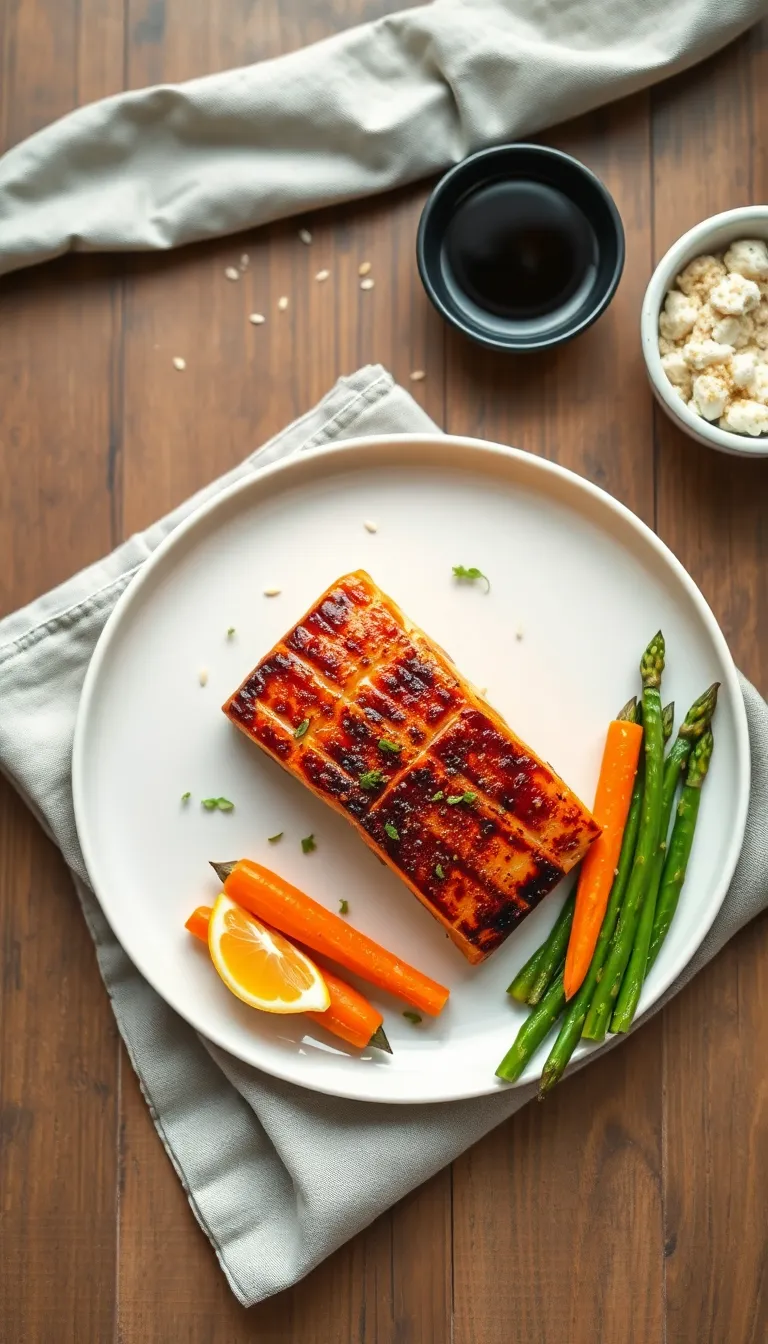
- Preheat the Grill: Ensure your grill is hot before placing the salmon on it. This prevents sticking and helps achieve a beautiful sear. Aim for medium-high heat to get those characteristic grill marks without overcooking.
- Use a Fish Basket: If you’re worried about the salmon falling apart, use a fish basket for grilling. It holds the fish securely and makes flipping easier, resulting in a perfectly cooked piece.
- Make the Sauce in Advance: Prepare the hibachi sauce a day ahead to allow the flavors to meld together. This can enhance the depth of flavor when you baste the salmon during grilling.
- Season Generously: Don’t be shy with the seasoning. A good pinch of sea salt and freshly cracked black pepper can bring out the natural flavors of the salmon, complementing the hibachi sauce beautifully.
- Rest the Salmon: After removing the salmon from the grill, let it rest for a few minutes. This allows the juices to redistribute within the fillet, ensuring a moist and flavorful bite every time.
- Chef’s Secret – Add a Citrus Zest: Just before serving, grate a bit of lemon or lime zest over the salmon. This adds a burst of freshness and enhances the overall flavor profile, making the dish more vibrant.
Common Mistakes to Avoid
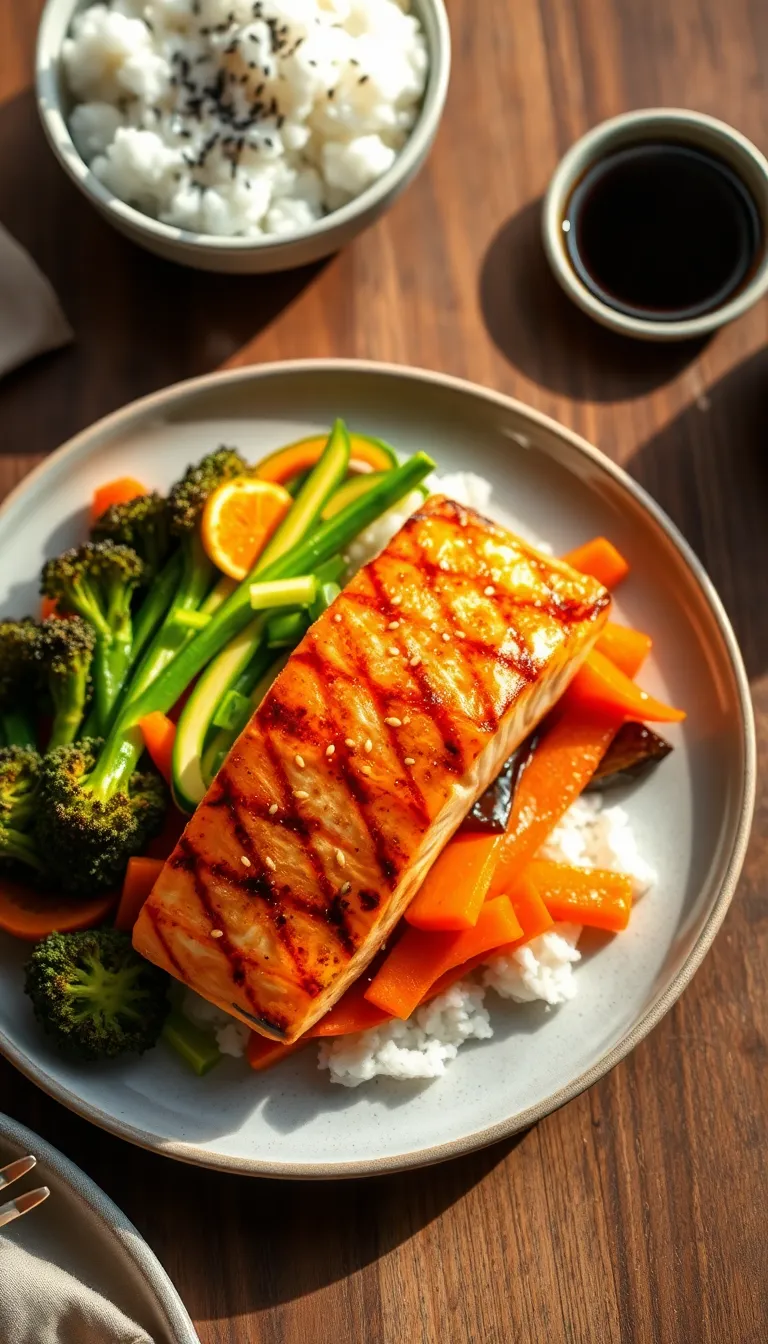
- Overcrowding the Pan: Placing too many salmon fillets in the pan at once can lead to steaming rather than searing, resulting in a lack of that desirable crispy crust. To avoid this, cook the salmon in batches if necessary, allowing space between each piece for proper air circulation and even cooking.
- Not Preheating the Pan: Starting with a cold pan prevents the salmon from searing properly, which can cause it to stick and break apart. Always preheat your pan over medium-high heat before adding the salmon, ensuring a hot surface that will help achieve a perfect sear.
- Using Cold Salmon: Cooking salmon straight from the refrigerator can lead to uneven cooking, with the outside overcooked and the inside underdone. Let the salmon sit at room temperature for about 15-20 minutes before cooking to ensure even cooking throughout.
- Ignoring the Skin: If your salmon has skin, it can act as a protective layer and add flavor. Many cooks remove it too early or fail to crisp it up. Cook the salmon skin-side down first to allow the skin to become crispy, and flip only once during cooking.
- Overcooking the Salmon: Salmon can become dry and tough if cooked for too long. Keep a close eye on the cooking time and use a meat thermometer to check for doneness. Aim for an internal temperature of 125°F to 130°F for perfectly cooked salmon.
- Skipping the Resting Period: Cutting into the salmon immediately after cooking can cause it to lose its juices and become dry. Allow the salmon to rest for a few minutes before serving to keep it moist and flavorful.
Storage and Reheating Tips
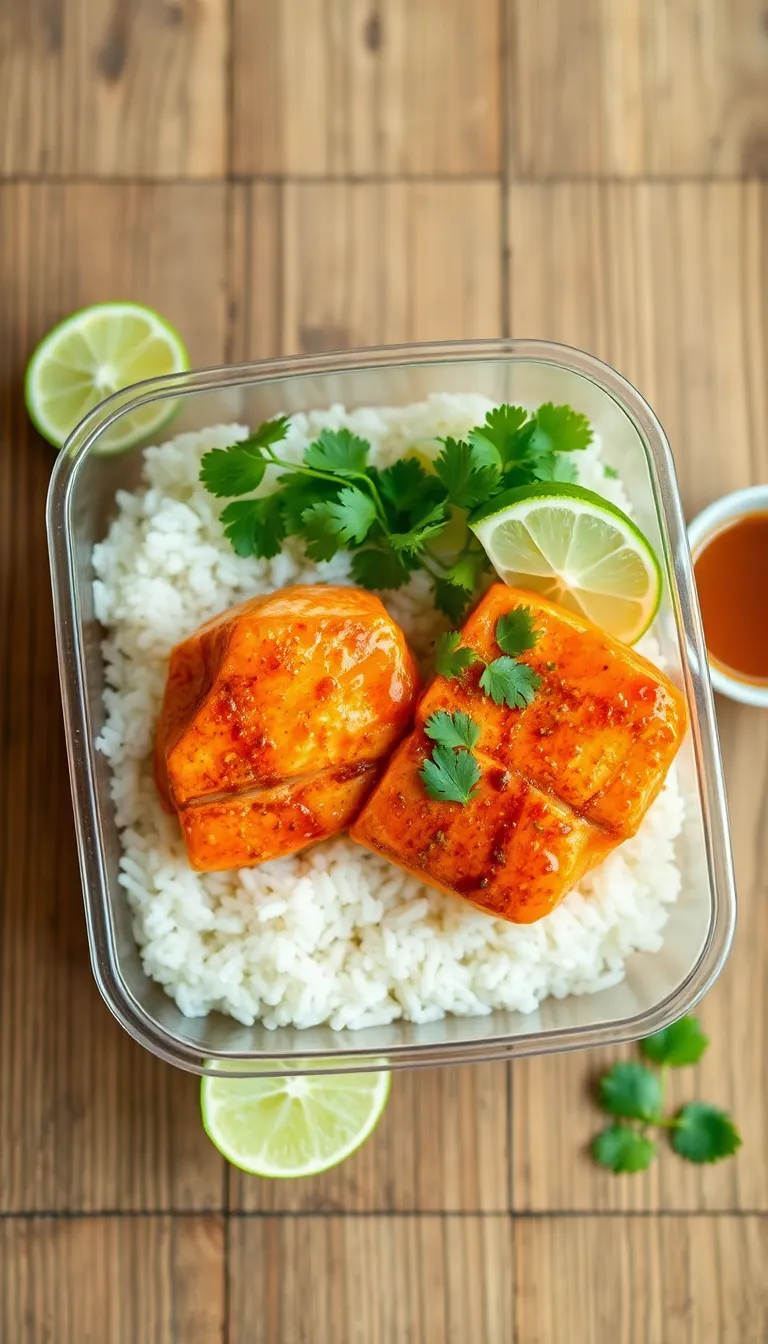
- Allow the hibachi salmon to cool to room temperature before storing to prevent condensation in the container.
- Place the salmon in an airtight container to maintain freshness and prevent the absorption of other odors from the fridge.
- Refrigerate the hibachi salmon within 2 hours of cooking to ensure food safety.
- The salmon can be stored in the refrigerator for up to 3 days. For best quality, consume it sooner rather than later.
- If you plan to keep the salmon for a longer period, consider freezing it. Wrap the salmon tightly in plastic wrap or aluminum foil, then place it in a freezer-safe zip-top bag or container. It can be frozen for up to 2 months.
- To reheat refrigerated salmon, preheat your oven to 275°F (135°C). Place the salmon on a baking sheet and cover it loosely with foil. Heat for about 15 minutes or until the internal temperature reaches 145°F (63°C).
- For a quicker reheating option, use a skillet. Heat a small amount of oil over medium-low heat and gently warm the salmon for about 5 minutes on each side.
- Avoid using a microwave for reheating, as it can dry out the salmon and alter its texture.
- When reheating frozen salmon, it’s best to let it thaw in the refrigerator overnight before following the reheating instructions. Never thaw salmon at room temperature to prevent bacterial growth.
- Always ensure the salmon is reheated thoroughly to a safe internal temperature of 145°F (63°C) before consuming.
Proper storage and reheating techniques are crucial for maintaining the quality and safety of your hibachi salmon. By following these tips, you can enjoy your delicious meal even as leftovers without compromising on taste or texture.
Frequently Asked Questions
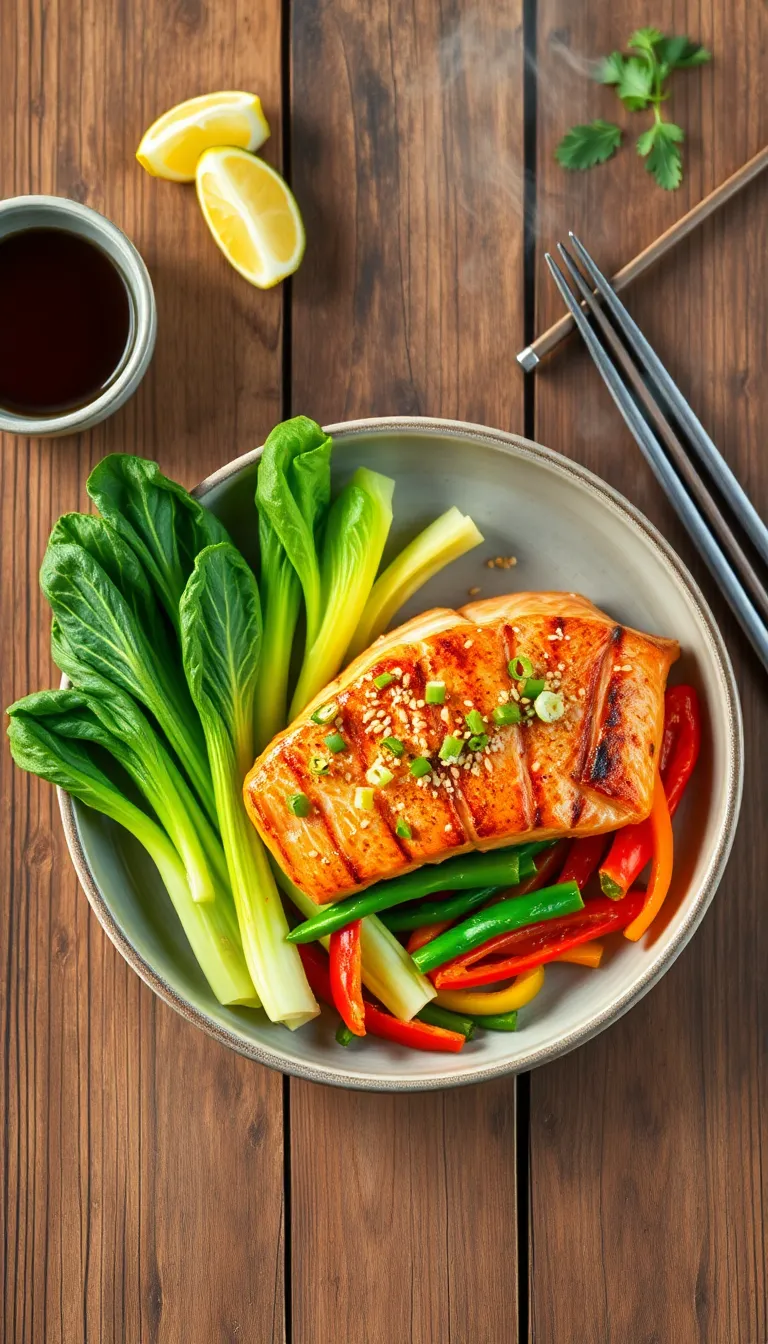
Q: Can I use frozen salmon for this recipe?
- Yes, you can use frozen salmon, but make sure to thaw it completely in the refrigerator before cooking for best results.
Q: What can I substitute for soy sauce if I’m gluten-free?
- Use tamari or a gluten-free soy sauce alternative to keep the dish gluten-free.
Q: How do I prevent the salmon from sticking to the grill?
- Ensure the grill is well-oiled and preheated before placing the salmon, and avoid moving it too soon to allow a crust to form.
Q: What side dishes pair well with Hibachi Salmon?
- Steamed rice, sautéed vegetables, or a simple green salad are excellent pairings for a complete meal.
Q: Can I make this recipe without a grill?
- Yes, you can use a cast iron skillet or a non-stick pan to achieve a similar sear on the salmon if a grill is unavailable.
Q: How can I tell when the salmon is fully cooked?
- The salmon is done when it reaches an internal temperature of 145°F (63°C) and flakes easily with a fork.
Final Thoughts
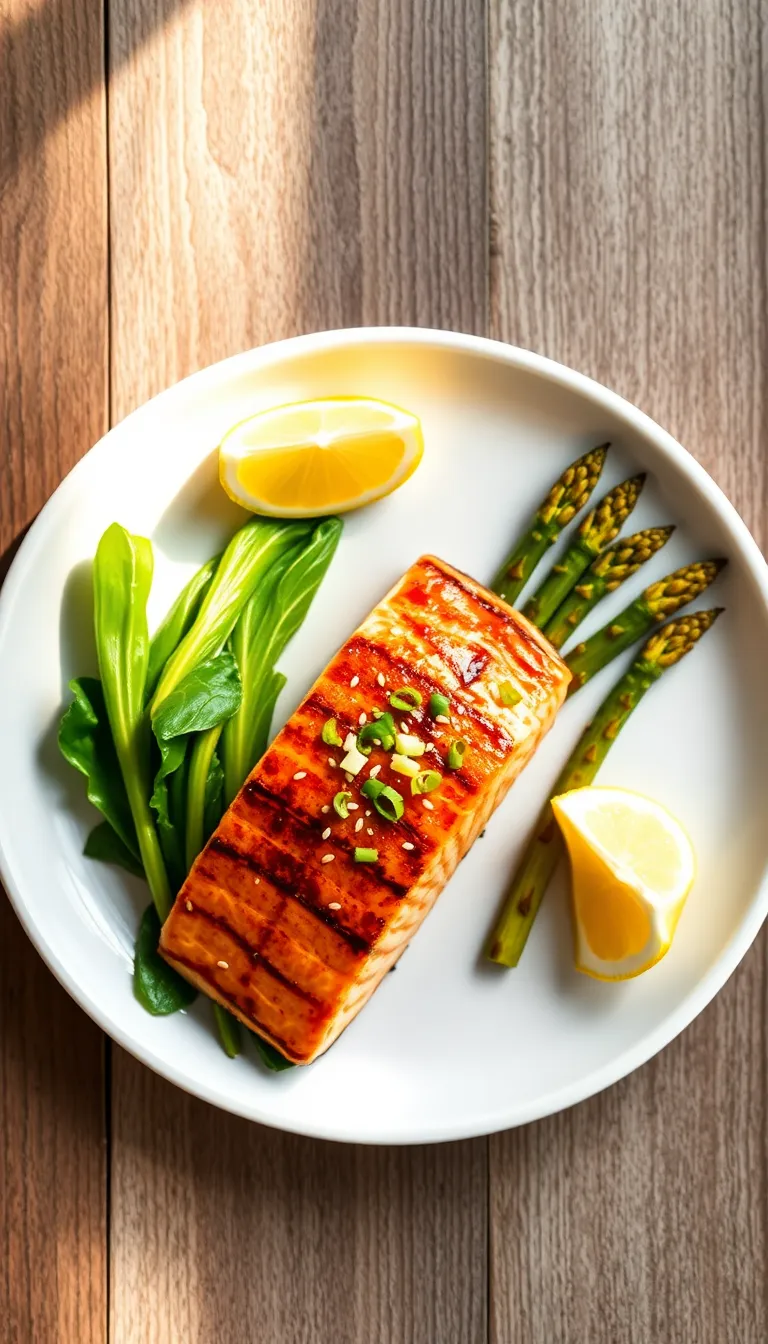
Hibachi Salmon is a delightful dish that brings the vibrant flavors of Japanese cuisine right to your home. With its succulent pieces of salmon cooked to perfection and paired with a savory sauce, this recipe is not only delicious but also incredibly easy to prepare. It’s a fantastic way to enjoy a restaurant-quality meal without leaving your kitchen.
Feel free to put your own spin on it by experimenting with different vegetables or spices. Cooking is a personal journey, and this Hibachi Salmon recipe is a wonderful canvas for your creativity. Whether you’re a beginner or an experienced cook, you’ll find joy in crafting this dish to suit your tastes.
We hope this recipe inspires you to gather your ingredients and enjoy the process of making something special. Embrace the flavors and have fun in your kitchen! We warmly invite you to try this Hibachi Salmon recipe and share it with your loved ones.

Hi, I’m Anjali Arora — the curious heart behind Feast Chase.
To be honest, I’ve always felt most at ease in my own company. I’m not exactly a people-person (small talk still makes me cringe), but there are two things I’ve always loved deeply: animals and food.
